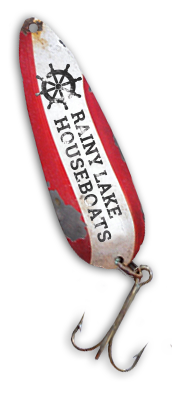We had a large snowfall in February, but the seasonal accumulation is still below normal on Rainy Lake. The first warming of the winter has started. The giant piles of plowed snow have started to melt along with the snowpack on the lake.
As this process begins. the melting snow creates weight on the ice. The melted water escapes down the cracks, old fishing holes in the ice and down open areas along pressure ridges. It’s a party for fish, otters, mink and other critters that live in our lake environment. The water draining in provides new oxygen for the lake. The walleyes, whitefish, northern pike, beavers, mink, and otters all see the change before we do.The process can take anywhere from 45-60 days until we see actual open water. During this time period, Rainy Lake changes faster than any other time of the year. It is truly amazing how the birds, waterfowl, eagles, loons and many types of forest birds recognize when it is time to head north. The loons that live in our bay seem to know the exact day there will be enough water to land.
 Most people who live near lakes see the results of the spring thaw around current areas. On a large lake like Rainy, it really begins in the many marshes on the lake. The creeks from the beaver ponds and small lakes feeding Rainy melt the ice in the marshes. The water warms every day creating more open water. With the warmer water metabolism increases in fish, beavers, otters, muskrat, and mink. The northern pike spawn first on Rainy Lake. These fish spawn when the main lake still has ice on it.
Most people who live near lakes see the results of the spring thaw around current areas. On a large lake like Rainy, it really begins in the many marshes on the lake. The creeks from the beaver ponds and small lakes feeding Rainy melt the ice in the marshes. The water warms every day creating more open water. With the warmer water metabolism increases in fish, beavers, otters, muskrat, and mink. The northern pike spawn first on Rainy Lake. These fish spawn when the main lake still has ice on it.
This year, our opening day is May 11th. May and June are some of the best times to visit Rainy Lake. Killer fishing, the best time to see all of our birdlife, the forest of Voyageurs National Park being rejuvenated from a long winter, loons courting each other, and easily visible nesting eagles. We can’t wait!
Get a jump start on planning your houseboat trip so you can see it too! Contact our team to reserve a houseboat and see all of them.



